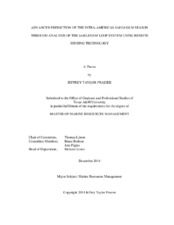| dc.description.abstract | Sargassum is a common type of seaweed observed in the Sargasso Sea, located in a portion of of the western mid-Atlantic. Seasonally Sargassum inundates the beaches of Texas and the cost for its removal results in great strain on the coastal economies. Although this is an annual occurrence its cyclic migration patterns are relatively unknown. The research reported herein investigates the following null hypothesis, that Sargassum does not enter the Gulf of Mexico via the northern passages of the Caribbean and Yucatan Strait, where it amasses on the shores of the Gulf Coast or gets carried out the Florida Strait, in what is known as the Sargassum loop System. Once a seasonal migration patter is discerned, it is then hypothesized that certain aspects of the upcoming Sargassum season can be predicted in advance, using satellite imagery to monitor the corridors between the Sargasso Sea and the Gulf of Mexico.
The Sargassum season was previously thought to be erratic and unpredictable, however the theory of the Sargassum loop system sheds light on the seasonal migration patterns of the macro-algae. Through use of NASA’s Landsat satellite imagery the presence and abundance of Sargassum has been analyzed. Based on several factors, such as ocean currents, wind patterns, time of the year, and size of seaweed mats, the arrival and intensity of the upcoming Sargassum season can be approximated prior to its arrival in the Sargassum loop system. The Sargassum season starts months in advance in the Sargasso Sea when high pressure anomalies form. Their formation creates circulating northern wind currents that direct Sargassum southbound into the Caribbean latitudes. Once Sargassum has entered the Caribbean Passages, the Gulf Stream carries it westward, where depending on the direction and magnitude of ocean and wind currents, the Seaweed can take from two to five months to reach the Texas Coast. The Sargassum that does not reach land is flushed through the Florida Straits and returns to the Sargasso Sea. This creates the Sargassum season. Remote sensing, along with data from other ocean monitoring devices provides the necessary data for use in a Sargassum Early Advisory predictive model that allows for a more advanced warning of its arrival. | en |


